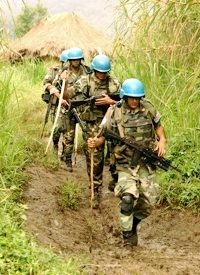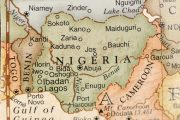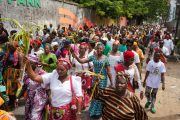
Citing a statement from an aid worker in the Congo, an August 23 MSNBC report revealed that rebels in eastern Congo gang-raped nearly 200 women and some young boys during a four-day period between July 30 and August 3. The rapes took place only a few miles from a UN peacekeepers’ base.
The aid worker was identified as Will F. Cragin of the International Medical Corps, who told the Associated Press by telephone that rebels had occupied Luvungi town the day after an attack that began on July 30.
Cragin said that his organization was only able to go into the town that is 10 miles from a UN military camp after rebels withdrew voluntarily on August 4. He said there was no fighting and no deaths, but "lots of pillaging and the systematic raping of women" by between 200 and 400 rebels. "Many women said they were raped in their homes in front of their children and husbands," Cragin said, adding that others were dragged into the nearby forest to be assaulted.
He said international and local health workers have treated 179 women, but that the number of rape victims could be much higher. Cragin said his aid group has been going back to the town and identifying more cases.
More than three weeks after the spree, the UN mission has issued no statement about the atrocities and said it is still investigating.
An August 23 report from Reuters News service identified the attackers as Rwandan Hutu FDLR insurgents and Mai Mai militia. The report quoted Stefania Trassari, spokesperson for the United Nations Office for the Coordination of Humanitarian Affairs (OCHA), who said: "During the attack [the rebels] looted [the] population’s houses and raped several women in Luvungi and surrounding areas. International Medical Corps (IMC) reported that FDLR systematically raped the population during its four-day stay in Luvungi and surrounding areas. A total of 179 cases of sexual violence were reported.”
Reuters also quoted a statement from the IMC, which said it was treating the victims, noting: "Nearly all reported rapes were described as having been perpetrated by two-to-six armed men, often taking place in front of the women’s children and husbands.”
The New York Times report on August 23 provided more information about FDLR (Democratic Forces for the Liberation of Rwanda), the group blamed for the attacks, stating that it was “an ethnic Hutu rebel group that has been terrorizing the hills of eastern Congo for years, preying on villages in a quest for the natural resources beneath them.”
The Times also quoted Will F. Cragin of the International Medical Corps, who described the rebels’ assault: “They told the population that they were just there for food and rest and that they shouldn’t worry. Then after dark another group came. They began to systematically rape the population.”
The Times report noted:
The F.D.L.R., which began as a gathering of fugitives of the Rwandan genocide in 1994, has grown into a resilient and savage killing machine and an economic engine in the region.
The United Nations, Congo and Rwanda began a military offensive against the group in early 2009, but since then, humanitarian organizations say, cases of rape have risen drastically.
The Rwandan genocide was a tragic aftermath to the Rwandan Civil War that had started in 1990, which ended in a ceasefire in 1993. Fighting resumed in 1994 and over the course of approximately 100 days, between 500,000 and 1,000,000 Tutsis and moderate Hutus who opposed the killing were killed. Responsibility for the atrocities has been disputed by the opposing factions. At the time of the genocide, the UN came under intense criticism for its ineffectiveness in preventing the killing.
Compared to some of the world body’s actions in Africa, however, “ineffectiveness” may be a preferred attribute. As Alex Newman observed in his article “UN-Backed Troops Wreak Havoc in Africa” on January 13:
In the Democratic Republic of the Congo, a civil war that has claimed over five million lives still rages. And the UN is making matters much worse. The UN-backed Congolese and Rwandan militaries have been on a mission to disarm a rebel group known as the Democratic Forces for the Liberation of Rwanda (FDLR). But the results of the effort have been disastrous, according to an umbrella group of 84 organizations called the Congo Advocacy Coalition and a report commissioned by the UN itself. ??"For every rebel combatant disarmed, one civilian has been killed, seven women and girls have been raped, six houses have been burned and destroyed and 900 people have been forced to flee their homes," the coalition calculated. The UN-backed operations have “resulted in an unacceptable cost for the civilian population,” the group said in a press release.
Unfortunately, the UN’s history of making matters worse in Africa — especially in the Congo region — goes back years farther. UN troops committed numerous atrocities in 1960 while trying to subjugate the peaceful Congolese province of Katanga. Those atrocities, which were documented by 46 civilian doctors (in a 96-page booklet entitled 46 Angry Men) included the murder and assassination of unarmed civilians, rape, unmotivated machine-gunning of civilian homes, and the bombing and destruction of hospitals, ambulances, schools, and churches.
When the government of the pro-Western, pro-free enterprise Christian leader of Katanga, Moise Tshombe, seceded from the Congo in 1960, Belgian troops, who had maintained order since Belgian colonial rule in the former colony, had temporarily restored order. However, as we noted in our article "Champion of Freedom?" (a biography of Moise Tshombe) in The New American magazine for March 2, 1987:
UN troops moved into Katanga, NATO ordered the Belgians out, and the blood-bath began. In northern Katanga (but south of the Congo) Baluba tribesmen under Lumumba ally Jason Sendwe took advantage of the vacuum created by the withdrawal of the Belgians to stage an insurrection. The BALUBAKAT Jeunesse terrorists went on a rampage, murdering tribal chiefs and civilians with equal indiscretion. Brutal killings took place as a matter of policy as the Jeunesse dismembered Africans and Europeans alike.?
But the worst was yet to come for Katanga:
From December 1961 until Tshombe, unable to continue the fight, proclaimed "the end of the State of Katanga" on January 17, 1963, the UN troops engaged in one long orgy of sadistic violence. The archbishop of Elisabethville indicted them for "sacrilege, vandalism, murder, looting and rape." During that period, 46 doctors in Elisabethville sent 30 telegrams appealing for mercy to the outside world. The following (Number 27) is indicative of their plight:??
Addressee: U Thant — U.N.O. — New York — U.S.A.?Text: Are forced to repeat U.N.O. is most flagrant liar — stop — Ten more shells fall on Prince Leopold Hospital situated 500 meters from military camp — stop — Ranging error inacceptable as U.N.O. was warned about 8 p.m. by International Red Cross Delegate after fall of first shell — stop — Bombardment meanwhile continued during whole night — stop — Complaint made against you and your henchmen before all justices of civilized countries for war crimes which you cover shamelessly.?
Signed: The 46 Civilian Doctors of Elisabethville.
The UN is likely to come under criticism for once again exhibiting "ineffectiveness" in stopping these latest atrocities in the Congo, though they pale in comparison with the Rwandan genocide. However, given a choice between a UN that aids and abets the worst elements engaged in civil wars occurring in third-word nations — and a UN that is merely “ineffective” — ineffectiveness is probably to be preferred.
But a better solution would be for the United States to withdraw its membership in and support of the UN altogether.
Photo: In this Oct. 3, 2009 file photo, UN "peacekeepers" patrol near their encampment in the village of Kimua, in the heart of territory controlled by Rwandan Hutu rebels, in eastern Congo: AP Images



